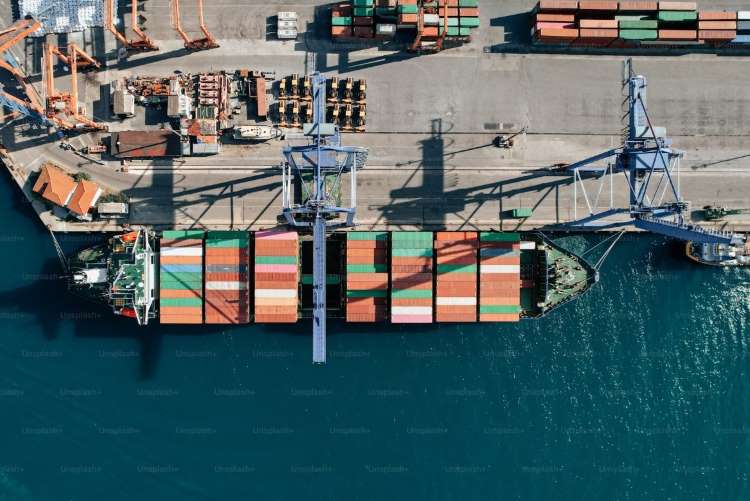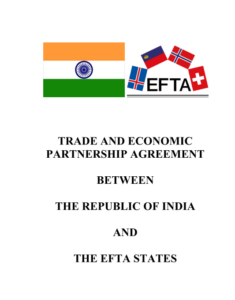
India recently concluded a trade and economic partnership agreement with the European Free Trade Association – a four-nation bloc comprising Iceland, Liechtenstein, Norway, and Switzerland. While the bilateral trade between the two sides is relatively low at $18 billion in FY 2023, trade complementarities exist. Currently, India runs a trade deficit of $14 billion with EFTA countries, with over 90% of bilateral trade occurring with Switzerland, followed by Norway. Under the India-EFTA deal, the European partners have offered complete market access for 93% of their tariff lines.
The MFN and applied rates are already some of the lowest in the world with Switzerland abolishing customs duties on all goods other than agricultural and fisheries products. India’s offer covers 83% of its tariff lines, with phased elimination over an extended period. A notable feature of this trade pact is the investment chapter, under which EFTA countries have committed to $100 billion of foreign direct investment over the next 15 years, creating one million jobs within that period. The investments will flow in phases – $50 billion in the first 10 years, followed by another $50 billion in the next five years.
READ I Outdated population data puts Kerala’s finances in a fix
The India-EFTA deal
The India-EFTA deal is unique in linking investment and job commitments to tariff concessions. These commitments are not subject to dispute settlement; instead, the TEPA includes a government-to-government mechanism to resolve differences and allows India to take remedial measures if EFTA fails to fulfil its $100 billion commitment. The timeframe for resolving differences under this mechanism is 10 to 25 years. While such disputes are best left to bilateral negotiations, there is a need for a dynamic model that goes a step further than the TEPA.

Economists have long highlighted how free trade can maximise welfare. However, in an increasingly polarised world where geopolitical fragmentation is the norm, the ability of FTAs to achieve this becomes more complex. Can we ignore the redistribution or social impact of free trade when a few countries control international trade?
Opponents of trade liberalisation cite India’s experience with various FTAs, while supporters offer theoretical foundations without quantifying benefits to India from these agreements. The imbalance in negotiating strength between developing and developed countries exacerbates the situation. To correct this imbalance, we need a fresh perspective on FTAs.
Historically, India has viewed FTAs as international treaties. Instead, we should see them as commercial contracts. A good commercial contract precisely outlines the benefits for each party and captures the key risks, prescribing corrective actions if those risks materialise. Vague statements in FTAs do little to mitigate such risks. We can take inspiration from the Fiscal Responsibility and Budget Management Act, 2003, which systematically unfolds objective targets, risks, strategic priorities, and government commitments.
A new model for FTAs
While the India-EFTA deal is a step in the right direction, India must go further to seek tangible benefits from an FTA. We suggest replacing vague and lofty objectives with a hard equation that addresses (a) trade deficit as a perception and real issue, (b) access to capital, and (c) access to technology. This equation should prescribe a threshold for the trade deficit, which, if not compensated by capital, cheaper debt, access to technology, or visas, would result in suspended concessions.
For example, concessions on goods or services could be suspended if the trade deficit hits a pre-decided ceiling. Concessions would be restored only when the trading partner imports from India, provides access to capital, or adopts other methods such as infrastructure investment (G2G) or technology transfer (B2B) of a specified value. The equation could be sectoral or broader, depending on the negotiation terms. This approach would eliminate extensive negotiations on tariff concessions and conditionalities attached to FTAs. We foresee this template being most effective in bilateral trade deals rather than mega-regional agreements.
This approach would provide both parties with corrective actions against risks arising from an FTA, such as unilateral domestic measures. For example, the EU intends to introduce CBAM before committing to any tariff concessions, potentially negating any concessions given by the EU side.
Strengthening review mechanism
Another drawback of the FTAs is the notion that negotiations are static and all commitments are frozen at the inception of the FTAs. The review mechanisms would become more meaningful with such a clause. Through periodic reviews of the FTA, both trading partners could agree to a larger tolerance for a specific sector if the quality of trade improves over time for the country experiencing a trade deficit, i.e., movement up the value chain.
This ensures that negotiations are not purely based on the trade deficit and incentivises both trading partners to continue the contract. Countries wishing to continue preferential trade will exercise the option or plan their trade according to the threshold. We believe that actual data, instead of theory, is the best foundation for trade negotiations and that trade negotiations are continuous rather than a one-time static event.
Whether this equation would be acceptable to trading partners is uncertain. However, such a proposal would compel trade partners to invest in India’s growth story if they want unrestricted market access. The equation would never be triggered for trade partners engaging in equitable trade. However, those with no intention of buying from or investing in India would hesitate to sign such agreements.
The call for Atmanirbhar Bharat should not be understood as protectionism or isolation. Reliance on quality and price-competitive imports in sectors where India lacks capability is inevitable. Hence, India’s trade policy and FTA strategy must emphasise comprehensive and deep FTAs that focus on moving up the value chain. This could mean turning to traditional markets like the United States, the European Union, and the United Kingdom.
FTAs with maximum trade complementarities, high utilisation ratios, and easy communication with the general public will render maximum benefits and enjoy voter support. With its strong growth story and large domestic market, India is positioned to design such an equitable FTA. The TEPA is just the beginning.
(Atul Sharma is co-founder of Sarvada Legal. Prachi Priya is an economist based in Mumbai.)
